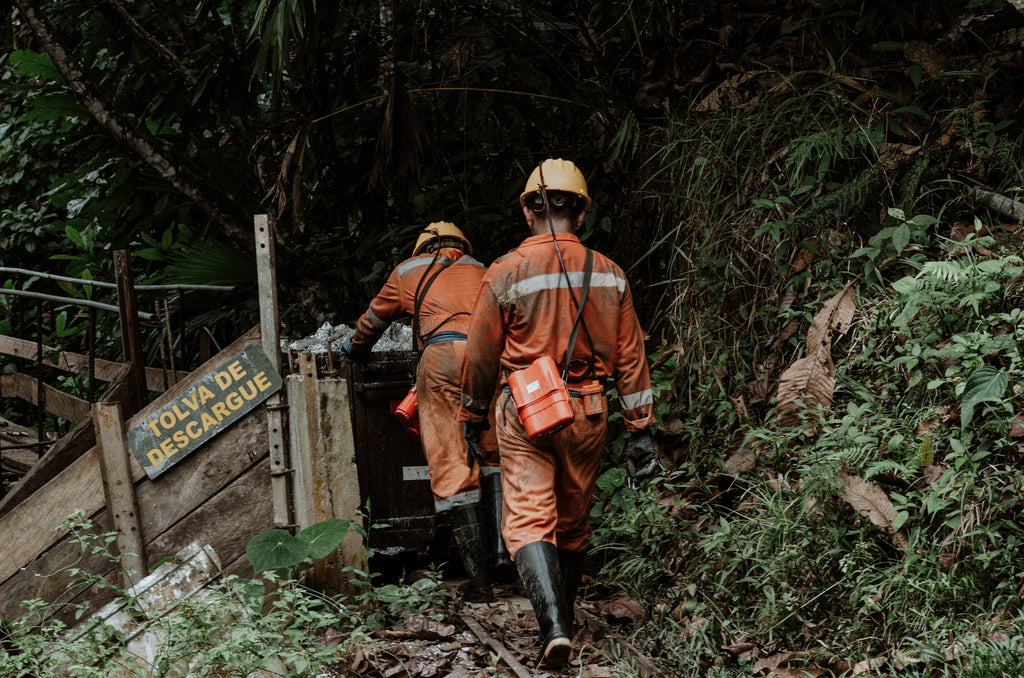Every conversation about ethical jewellery has to begin at the source; the extraction of the metals. This holds particularly true for precious metals like gold and silver, where corporate and conventional mining practices are so often marred by social and environmental destruction. Enter Fairmined – a certification that promises a brighter, more sustainable future for miners, ecosystems and consumers alike. So, what is Fairmined gold and silver and why are we so passionate about them as the ethical choice for conscious jewellery.
 Miners at Iquira, Colombia
Miners at Iquira, Colombia
Social Impact
At the heart of Fairmined lies a dedication to improving the lives of artisanal and small-scale miners (ASM) in developing countries. By 2013, it was estimated that globally, between 100 and 150 million people relied on artisanal and small-scale mining (ASM) for their livelihoods [1]. However, miners often work under harsh conditions with limited access to clean water, healthcare, education, and fair wages. Artisanal mining is frequently associated with illegality, violence, smuggling, and environmental destruction. Miners frequently come into contact with hazardous chemicals like mercury, which not only jeopardize their and their community’s health but also bioaccumulate, having far reaching deadly consequences for ecosystems and food chains.
The Fairmined Standard seeks to address these challenges by reforming the often opaque and exploitative conventional gold trade. It promotes fairer practices that improve the social, economic, and environmental conditions of miners and their communities
In contrast to commercial mines, ASM (artisanal small-scale mines) are often owner operated and, to varying degrees, rely on rudimentary mining technologies. Whilst ASMs produce only 20% of the global gold supply, they employ 80% of the global workforce involved in gold extraction (the remaining 20% are employed in large scale, commercial gold mining)[2]. By focusing on ASMs, Fairmined certification has the potential to make a meaningful difference in the lives of the greatest number of people involved in, or affected by, gold mining.
 The Oro Puno mining team, Peru
The Oro Puno mining team, Peru
In order to become Fairmined certified an ASM must comply with the strictest legal, organizational, labour, technical, social and environmental requirements as laid out by the Alliance for Responsible Mining as well as the individual country’s own laws.
Once certified, Fairmined mining organisations receive a fair price (established by market rates) for their metals as well as an additional Fairmined Premium. This premium, $4 for every gram of Fairmined gold (extracted with responsible chemical management) and $6/gram in the case of Fairmined ECO gold (extracted without the use of chemicals), is reinvested into sustainable mining practices as well as used to improve the lives of miners, their families and surrounding communities. Thus, the Fairmined Premium not only rewards responsible mining practices but also provides crucial funds for mining organisations to realize their sustainable development goals [3]
For those interested, the Fairmined 2022 Premium Report offers valuable insights into how specific Fairmined mines utilised their premiums, which included investments in safety equipment, development of local schools and clinics and road building.
The Fairmined standard actively promotes gender equality and prohibits child labor. To work underground in a Fairmined certified mine, miners must be at least 18 years old, a stark contrast to many mining operations where children as young as nine are witnessed underground and even younger children are involved in surface-level ore processing [4].
Both independent auditors and The Alliance for Responsible Mining’s own team conduct annual visits to the mines to verify compliance with the Fairmined standard and assess ongoing improvements. Fairmined invests time and resources into sharing knowledge and providing training, both directly and through partner organisations, to candidates of Fairmined certification, covering a vast array of issues related to health and safety [5]. This grassroots approach fosters positive, long-term change to the mining environment and safeguards workers.

 A miner at Iquira
A miner at Iquira
Environmental Stewardship
The mining of precious metals worldwide exacts a significant ecological toll. Gold mining, in particular, can have devastating consequences, as evidenced by incidents like the Baia Mare (Romania) mine's tailings dam burst, which caused cyanide and heavy-metal sludge spills, contaminating river systems for 40 kilometeres [6].
In response to this tainted history, Fairmined certification mandates that its mining partners leave a positive environmental legacy by adhering to environmental laws, contributing to environmental protection through restoration and minimising the ecological footprint of mining.
Certification operates on a two tier system for environmental protections; Fairmined Gold and Fairmined ECO gold. The former requires the responsible use of chemicals, ensuring that minimal amounts are used and that there is no runoff into waterways or leaching into soils. Fairmined ECO requires the complete elimination of toxic chemicals from the mining process.

Whilst not a requirement of certification, some Fairmined mines also choose to explore diversified livelihoods, using their land for farming as well as mining. In doing so a symbiotic relationship between miner, mine and soil is established further entrenching the incentive for responsible environmental practices.
 AuTerra's god and silver granules and one of the hardworking Fairmined miners.
AuTerra's god and silver granules and one of the hardworking Fairmined miners.
Transparency and Traceability
Every participant in the Fairmined value chain, including miners, refineries, and jewelers, undergoes rigorous audits and assessments to ensure compliance with Fairmined standards. This transparency fosters trust and accountability between all the partners along the chain.
Fairmined certified gold and silver come with a guarantee of traceability. Every gram can be traced back to a specific Fairmined mine, allowing both us as jewellers and you as the wearer, to forge a personal and emotional connection with the miners and to become directly tied to the story of their communities.
"Fairmined encourages continuous improvements, sustainability is a process not a destination."
To be as inclusive as possible the Fairmined certification scheme works on a tiered system, placing different expectations (the issues mentioned above as the base levels of compliance) on mining operations for each year they are a member of the Fairmined certification scheme. This is also where the Fairmined Premium comes in, allowing mining operations to improve heath, safety and environmental stewardship year on year with the assistance of the reinvestment of the Fairmined premium.
Fair mined stands ready to lead the charge towards a fairer, more sustainable future for all involved in the mining process. Truly gold and silver to be proud of.
AuTerra's Fairmined Gold and Silver
Currently (2025 batches), our gold originates from the Fairmined certified mine in Peru, Oro Puno. Located in the mountainous Puno region, this cooperative, comprising 25 workers, has been Fairmined certified since 2018.
Our Fairmined Silver originates from the Iquira Mine in Colombia. This cooperative supports 115 workers, 20% of whom are women. Due to its location in the famous Colombian coffee zone, miners seasonally alternate between artisanal mining and coffee growing.
Both AuTerra’s gold and silver are extracted without the use of any mercury. Mercury, commonly used to separate the gold from the ore, is highly toxic and causes irreversible damage to the environment. When released during mining, it contaminates soil, water, and air, spreading through ecosystems and entering the food chain resulting in severe harm to human health. The human and environmental toll of mercury is severe, with the the United Nations declaring it one of the biggest threats to the future of our planet [7]. Eliminating mercury is an essential tenet of sustainable mining.

References:
[1] [2] Global Trends in Artisanal and Small-Scale Mining (ASM): https://www.iisd.org/system/files/publications/igf-asm-global-trends.pdf
[3] https://www.responsiblemines.org/en/our-services/fairmined-certification/
[4] Artisanal and Small-Scale Mining: Challenges and Opportunities https://www.iied.org/sites/default/files/pdfs/migrate/9268IIED.pdf
[5] https://www.lebrusanstudio.com/pages/artisanal-gold
[6] https://www.grida.no/resources/11432
[7] https://www.unep.org/news-and-stories/story/why-mercury-still-threat-human-and-planetary-health

